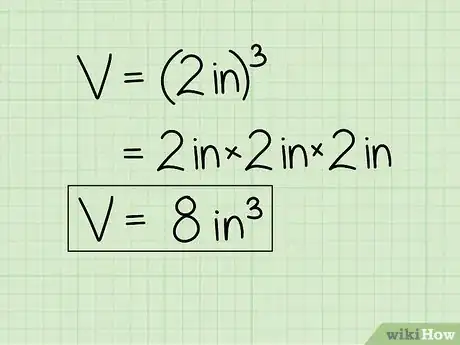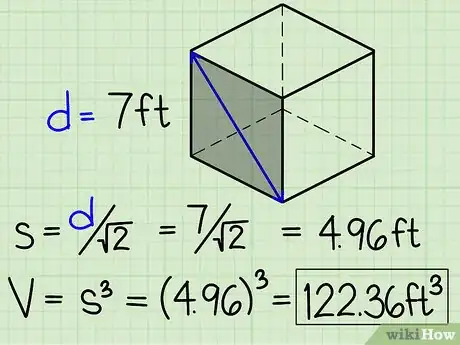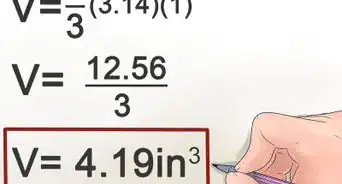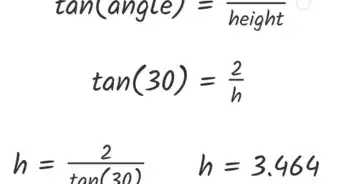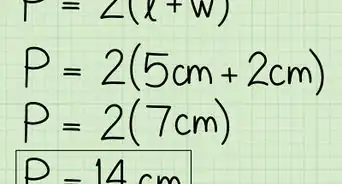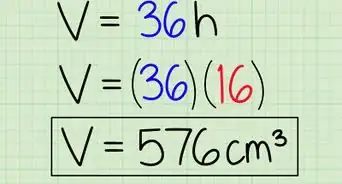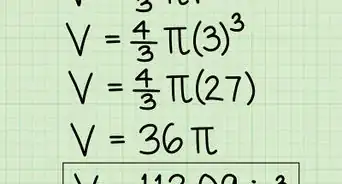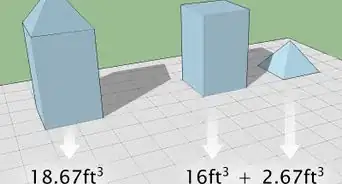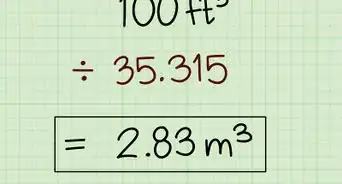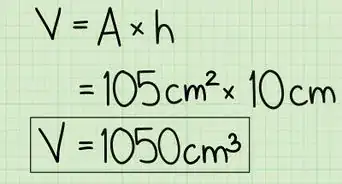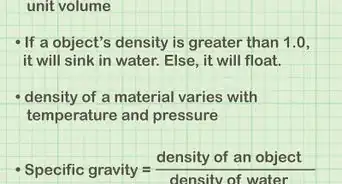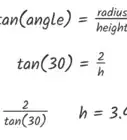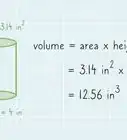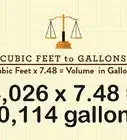This article was co-authored by David Jia. David Jia is an Academic Tutor and the Founder of LA Math Tutoring, a private tutoring company based in Los Angeles, California. With over 10 years of teaching experience, David works with students of all ages and grades in various subjects, as well as college admissions counseling and test preparation for the SAT, ACT, ISEE, and more. After attaining a perfect 800 math score and a 690 English score on the SAT, David was awarded the Dickinson Scholarship from the University of Miami, where he graduated with a Bachelor’s degree in Business Administration. Additionally, David has worked as an instructor for online videos for textbook companies such as Larson Texts, Big Ideas Learning, and Big Ideas Math.
There are 7 references cited in this article, which can be found at the bottom of the page.
This article has been viewed 1,640,243 times.
A cube is a three-dimensional shape that has equal width, height, and length measurements. A cube has six square faces, all of which have sides of equal length and all of which meet at right angles.[1] Finding the volume of a cube is a snap - generally, all that's needed is to multiply the cube's length × width × height. Since a cube's sides are all equal in length, another way of thinking of a cube's volume is s3, where s is the length of one of the cube's sides. See Step 1 below for a detailed breakdown of these processes.
Steps
Help Finding Volume of a Cube
Cubing One of the Cube's Sides
-
1Find the length of one side of the cube.[2] Often, in problems asking you to find the volume of a cube, you'll be given the length of one of a cube's sides. If you have this information, you have all you need to solve for the cube's volume. If you're not solving an abstract math problem but are instead attempting to find the volume of a real-life object shaped like a cube, use a ruler or measuring tape to measure the side of the cube.[3]
- To better understand the process of finding the volume of a cube, let's follow along with an example problem as we go through the steps in this section. Let's say the side of the cube is 2 inches (5.08 cm) long. We'll use this information to find the volume of the cube in the next step.
-
2Cube the length of the side. When you've found the length of one of the cube's sides, cube this number. In other words, multiply it by itself twice. If s is the length of the side, you would multiply s × s × s (or, in simplified form, s3). This will give you the volume of your cube![4] [5]
- This process is essentially the same as finding the area of the base and then multiplying it by the cube's height (or, in other words, length × width × height), since the area of the base is found by multiplying its length and its width. Since the length, width, and height of a cube are equal, we can shorten this process by simply cubing any of these measurements.
- Let's proceed with our example. Since the length of the side of our cube is 2 inches, we can find the volume by multiplying 2 x 2 x 2 (or 23) = 8.
Advertisement -
3Label your answer with cubic units.[6] Since volume is the measure of three-dimensional space, your answer should be in cubic units by definition. Often, on math schoolwork, neglecting to label your answer with the right units can cause you to lose points on a problem, so don't forget to use the correct label!
- In our example, since our original measurement was in inches, our final answer will be labelled with the units "cubic inches" (or in3). So, our answer of 8 becomes 8 in3.
- If we had used a different initial unit of measurement, our final cubic units would differ. For instance, if our cube had sides with lengths of 2 meters, rather than 2 inches, we would label it with cubic meters (m3).
Finding Volume from Surface Area
-
1Find your cube's surface area. While the easiest way to find a cube's volume is to cube the length of one of its sides, it's not the only way. The length of a cube's side or the area of one of its faces can be derived from several other of the cube's properties, which means that if you start with one of these pieces of information, you can find the volume of the cube in a roundabout manner. For instance, if you know a cube's surface area, all you need to do to find its volume is to divide the surface area by 6, then take the square root of this value to find the length of the cube's sides. From here, all you'll need to do is cube the length of the side to find the volume as normal. In this section, we'll walk through this process step-by-step.
- The surface area of a cube is given via the formula 6s2, where s is the length of one of the cube's sides. This formula is essentially the same as finding the 2-dimensional area of the cube's six faces and adding these values together. We'll use this formula to find the volume of the cube from its surface area.[7]
- As a running example, let's say that we have a cube whose surface we know to be 50 cm2, but we don't know its side lengths. In the next few steps, we'll use this information to find the cube's volume.
-
2Divide the cube's surface area by 6. Since the cube has 6 faces with equal area, dividing the cube's surface area by 6 will give you the area of one of its faces. This area is equal to the lengths of two of its sides multiplied (l × w, w × h, or h × l).[8]
- In our example, dividing 50/6 = 8.33 cm2. Don't forget that two-dimensional answers have square units (cm2, in2, and so on).
-
3Take the square root of this value. Since the area of one of the cube's faces is equal to s2 (s × s), taking the square root of this value will find you the length of one of the cube's sides. Once you have this, you have enough information to solve for the volume of the cube as you normally would.[9]
- In our example, √8.33 is roughly 2.89 cm.
-
4Cube this value to find the cube's volume. Now that you've obtained a value for the length of the cube's side, simply cube this value (multiply it by itself twice) to find the volume of the cube as detailed in the section above. Congratulations - you've found the volume of a cube from its surface area.[10]
- In our example, 2.89 × 2.89 × 2.89 = 24.14 cm3. Don't forget to label your answer with cubic units.
Finding Volume from Diagonals
-
1Divide the diagonal across one of the cube's faces by √2 to find the cube's side length. By definition, the diagonal of a perfect square is √2 × the length of one of its sides. Thus, if the only information you're given about a cube is regarding the diagonal length of one of its faces, you can find the side length for the cube by dividing this value by √2. From here, it's relatively simple to cube your answer and find the volume of the cube as described above.[11]
- For instance, let's say that one of a cube's faces has a diagonal that is 7 feet long. We would find the side length of the cube by dividing 7/√2 = 4.96 feet. Now that we know the side length, we can find the volume of the cube by multiplying 4.963 = 122.36 feet3.
- Note that, in general terms, d2 = 2s2 where d is the length of the diagonal of one of the cube's faces and s is the length of one of the sides of the cube. This is because, according to the Pythagorean theorem, the square of the hypotenuse of a right triangle is equal to the sums of the squares of the other two sides. Thus, because the diagonal of a cube's face and two of the sides on that face form a right triangle, d2 = s2 + s2 = 2s2.
-
2Square the diagonal of two opposite corners of the cube, then divide by 3 and take the square root to find the side length. If the only piece of information you're given about a cube is the length of a 3-dimensional line segment stretching diagonally from one corner of the cube to the corner opposite it, it's still possible to find the volume of the cube. Because d forms one of the sides of a right triangle that has the diagonal between the two opposite corners of the cube as a hypotenuse, we can say that D2 = 3s2, where D = the 3-dimensional diagonal between opposite corners of the cube.[12]
- This is because of the Pythagorean Theorem. D, d, and s form a right triangle with D as the hypotenuse, so we can say that D2 = d2 + s2. Since we calculated above that d2 = 2s2, we can say that D2 = 2s2 + s2 = 3s2.
- As an example, let's say that we know that the diagonal from one of the corners in the base of the cube to the opposite corner in the "top" of the cube is 10 m. If we want to find the volume, we would insert 10 for each "D" in the equation above as follows:
- D2 = 3s2.
- 102 = 3s2.
- 100 = 3s2
- 33.33 = s2
- 5.77 m = s. From here, all we need to do to find the volume of the cube is to cube the side length.
- 5.773 = 192.45 m3
Community Q&A
-
QuestionIf the volume of a cube is 512 cubic meters, what are its side measurements?
 DonaganTop AnswererThe side length is the cube root of the volume.
DonaganTop AnswererThe side length is the cube root of the volume. -
QuestionA cube-shaped structure has sides 3 feet long. If I plan to fill it with gravel to a depth of 2.5 feet, how much gravel will I need?
 DonaganTop AnswererMultiply the area of the bottom of the cube by 2.5.
DonaganTop AnswererMultiply the area of the bottom of the cube by 2.5. -
QuestionIf the length is 2 meters, the height is 1 meter and the width is 2 meters of a water tank, how many gallons of water will the cube contain?
 Community AnswerFirst, you need to find the volume of the tank. This can be found by multiplying the length, height, and width altogether. When you do that, you get 4 cubic meters. Doing some research, you will find that 1 cubic meter is approximately equal to about 220 imperial gallons or 264.2 US liquid gallons. If you use the imperial gallons, then the tank would hold a little less than 880 imperial gallons. But if you use the US liquid gallons, it would hold slightly less than 1,057 gallons.
Community AnswerFirst, you need to find the volume of the tank. This can be found by multiplying the length, height, and width altogether. When you do that, you get 4 cubic meters. Doing some research, you will find that 1 cubic meter is approximately equal to about 220 imperial gallons or 264.2 US liquid gallons. If you use the imperial gallons, then the tank would hold a little less than 880 imperial gallons. But if you use the US liquid gallons, it would hold slightly less than 1,057 gallons.
References
- ↑ https://www.mathopenref.com/cube.html
- ↑ https://www.gigacalculator.com/calculators/volume-calculator.php
- ↑ https://www.mathopenref.com/cubevolume.html
- ↑ https://www.gigacalculator.com/calculators/volume-calculator.php
- ↑ https://www.mathopenref.com/cubevolume.html
- ↑ https://www.mathopenref.com/cubevolume.html
- ↑ https://www.cuemath.com/measurement/surface-area-of-cube/
- ↑ https://www.softschools.com/math/geometry/topics/surface_area_of_a_cube/
- ↑ https://www.softschools.com/math/geometry/topics/surface_area_of_a_cube/
About This Article
To calculate the volume of a cube, find the length of one of the sides of the cube. When you have this measurement, multiply it by itself 2 times to get the volume, which is called “cubing” the number. For example, if your cube has a length of 2, you would multiply 2 × 2 × 2 to get a volume of 8. Be sure to include the units cubed with your answer. To learn more, like how to find the volume if you have the cube's surface area, keep reading!




